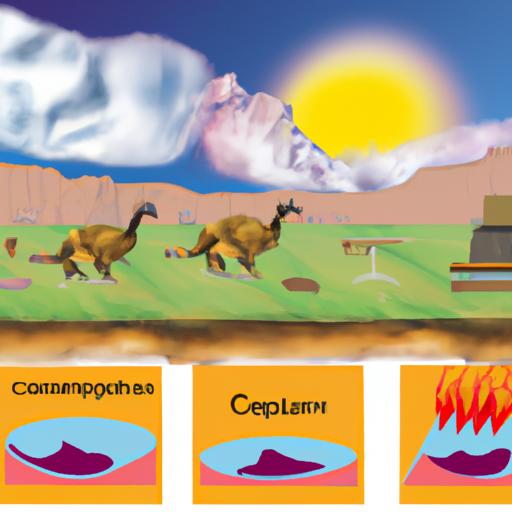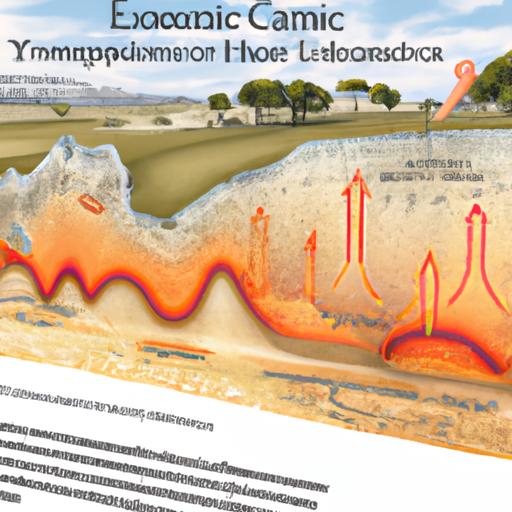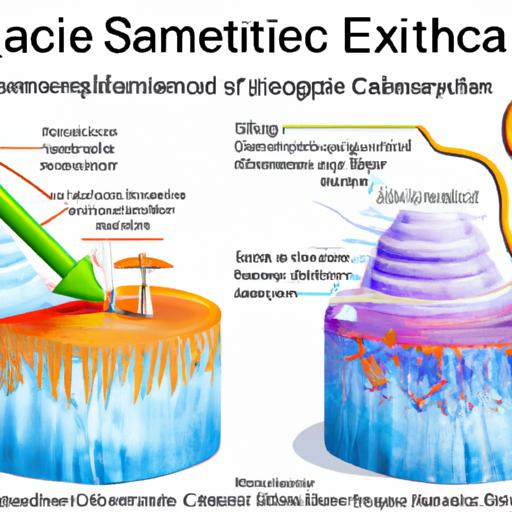This article may contain factual errors. It was created by the openai-ghostwriter 1.0.1. This is a python script for automatic generation of web pages powered by the OpenAI's GPT-3.
Dieser Artikel kann Unsinn und falsche Aussagen enthalten! Er wurde vom openai-ghostwriter 1.0.1 erzeugt. Das ist ein Python-Skript für die vollautomatische Erstellung von Webseiten.
Paleocene–Eocene Thermal Maximum

The Paleocene–Eocene Thermal Maximum (PETM) was a period of rapid global warming that occurred approximately 56 million years ago. It is believed to have been caused by a massive release of carbon into the atmosphere, leading to a dramatic increase in global temperatures. The PETM is one of the most studied events in Earth's history and has had a profound impact on our understanding of climate change and its effects on the environment.
The PETM began with an abrupt rise in atmospheric carbon dioxide levels, which increased by more than 1000 parts per million (ppm) over a period of about 10,000 years. This increase in CO2 led to a rapid rise in global temperatures, with estimates suggesting that average temperatures rose by 5-8°C over the course of the event. This warming was accompanied by significant changes in ocean chemistry and circulation patterns, as well as changes in vegetation and animal life.
The PETM is thought to have been caused by a massive release of carbon into the atmosphere from sources such as methane clathrates or volcanic eruptions. This release of carbon resulted in an increase in atmospheric CO2 levels that was much greater than any other known natural event. The effects of this sudden increase were felt around the world, with evidence for widespread ocean acidification and changes in ocean circulation patterns.
The PETM provides important insights into how our current climate is changing due to human activities such as burning fossil fuels. By studying this ancient event, scientists can gain valuable insight into how our planet responds to large-scale changes in atmospheric composition and temperature. In addition, it can help us understand how ecosystems may respond to future climate change and inform strategies for mitigating its impacts.
The PETM also serves as an important reminder that climate change can occur rapidly and unexpectedly. While it is difficult to predict exactly when or how future climate change will occur, it is clear that human activities are having an increasingly significant impact on our planet's climate system. As such, it is essential that we take action now to reduce our emissions and ensure that future generations are able to live on a healthy planet.
Background Information
 The PETM had a major impact on life on Earth. Many species went extinct, while others adapted to their new environment. It also led to major changes in ocean chemistry and circulation patterns, which had long-term effects on Earth's climate.
The PETM had a major impact on life on Earth. Many species went extinct, while others adapted to their new environment. It also led to major changes in ocean chemistry and circulation patterns, which had long-term effects on Earth's climate.
Geological Context
The PETM is thought to have been caused by a massive release of carbon into the atmosphere, likely from methane clathrates in the ocean floor or from volcanism. This carbon triggered a rapid increase in global temperatures and caused significant changes in ocean chemistry, including a decrease in oxygen levels and an increase in carbon dioxide levels. This led to a mass extinction event, with many species unable to adapt quickly enough to survive. The PETM is often used as an analog for modern climate change, as it provides insight into how ecosystems can respond to rapid changes in temperature and atmospheric composition. Studies of fossilized organisms from this time period have revealed that some species were able to adapt quickly enough to survive the event, while others were not so lucky. For example, planktonic foraminifera—tiny marine organisms that are important components of marine food webs—were able to survive the PETM by shifting their habitats deeper into the ocean where temperatures were cooler. The PETM also had a major impact on land-based ecosystems. Plants responded quickly to the increased temperatures and atmospheric CO2 levels by increasing their growth rates and photosynthetic efficiency. This led to an increase in plant biomass and productivity across terrestrial ecosystems, resulting in widespread vegetation changes such as increased grasslands at higher latitudes and expanded tropical forests at lower latitudes. The effects of the PETM on land-based animals were less clear cut than those on plants. Some species were able to adapt quickly enough to survive the event, while others went extinct or experienced population declines due to habitat loss or competition with newly adapted species. For example, horses experienced a significant decline during this time due to competition with newly adapted grazers such as rhinoceroses. In addition to its effects on terrestrial ecosystems, the PETM had major impacts on ocean life as well. The rapid increase in temperature caused coral reefs around the world to bleach out and die off due to thermal stress, leading to significant losses of biodiversity in these systems. Additionally, ocean acidification caused by increased CO2 levels resulted in decreased calcification rates among marine organisms such as mollusks and corals. Overall, the Paleocene–Eocene Thermal Maximum was one of the most dramatic climate events ever recorded in Earth’s history. Its effects on both terrestrial and marine ecosystems provide valuable insight into how our planet responds to rapid changes in temperature and atmospheric composition—insight that is especially relevant today given our current climate crisis.Climate Changes
The PETM began with a sudden and dramatic rise in atmospheric carbon dioxide levels. Scientists believe that this increase was caused by the release of large amounts of methane from deep-sea sediments. This methane was then oxidized into carbon dioxide, which then entered the atmosphere and caused global warming. The PETM lasted for approximately 200,000 years before temperatures began to decline again. During the PETM, global temperatures rose by up to 5°C (9°F). This rise in temperature had a profound effect on global ecosystems. Many species were unable to adapt quickly enough and became extinct. Other species were able to survive by migrating to more suitable habitats or evolving new adaptations. The PETM also caused changes in ocean circulation patterns, leading to an increase in oceanic productivity. The effects of the PETM are still visible today. For example, fossil records show that many species became extinct during this time, while others migrated or evolved new adaptations. Additionally, there is evidence that suggests that ocean circulation patterns were altered during this time, leading to increased oceanic productivity. The PETM provides important insight into how our current climate may respond to future increases in atmospheric carbon dioxide levels. By studying how ecosystems responded during this period of rapid warming, scientists can better understand how our current climate may respond if similar levels of warming occur again in the future. In addition to providing insight into future climate change scenarios, studying the PETM can also help us better understand how life on Earth has evolved over millions of years. By studying how different species responded during this period of rapid warming, scientists can gain a better understanding of how evolution works and how different species interact with each other. Overall, the Paleocene–Eocene Thermal Maximum was one of the most significant climate events of the past 65 million years. It had a profound effect on global ecosystems and provided important insights into how our current climate may respond if similar levels of warming occur again in the future.Impacts on Ecosystems

The Paleocene–Eocene Thermal Maximum (PETM) was a period of global warming that occurred around 56 million years ago. This event had a major impact on the Earth's ecosystems, resulting in a mass extinction of many species. The PETM is thought to have been caused by a large release of carbon dioxide into the atmosphere, which led to an increase in global temperatures by up to 5°C. This warming caused changes in ocean circulation and acidity, as well as changes in vegetation and animal distributions. These changes had a significant impact on the diversity and structure of ecosystems, leading to the extinction of some species and the emergence of new ones.
Marine Ecosystems
The PETM caused an increase in ocean acidification due to the absorption of carbon dioxide from the atmosphere. This led to a decrease in carbonate ion concentrations, which is essential for many marine organisms such as corals and mollusks. As a result, these organisms were unable to build their calcium carbonate shells and skeletons, leading to decreased abundance and diversity of these species. The PETM also caused an increase in sea level due to thermal expansion of water. This resulted in flooding of coastal habitats, leading to displacement of species adapted to shallow waters. In addition, the warmer temperatures caused changes in ocean currents and circulation patterns, resulting in disruption of food webs and migration patterns for many species. In addition to these direct impacts on marine ecosystems, the PETM also had indirect effects. For example, it caused an increase in atmospheric oxygen levels which led to increased respiration rates among marine organisms. This resulted in higher metabolic rates and greater energy demands, which put additional stress on species already struggling with environmental changes. The PETM also caused changes in nutrient availability due to increased runoff from land-based sources such as rivers and streams. This led to increased primary productivity in some areas but decreased productivity in others due to eutrophication or over-enrichment of nutrients. These changes had a profound effect on food webs as well as species distributions. Finally, the PETM caused changes in atmospheric chemistry that affected air quality. This led to higher levels of pollutants such as sulfur dioxide and nitrogen oxides being deposited into oceans, leading to further disruption of marine ecosystems. Overall, the Paleocene–Eocene Thermal Maximum had a major impact on marine ecosystems around the world. It caused direct changes such as ocean acidification and sea level rise as well as indirect effects such as increased nutrient availability and air pollution. These changes had far-reaching consequences for many species and their habitats.Terrestrial Ecosystems
The PETM was caused by the release of large amounts of carbon dioxide into the atmosphere, likely from methane hydrates in the ocean floor. This led to an increase in global temperatures and a decrease in ocean pH levels. The effects were felt across all terrestrial ecosystems, from deserts to forests. In particular, tropical rainforests were affected by increased temperatures and decreased precipitation. The rise in temperature caused by the PETM had a significant impact on plant life. Many species were unable to cope with the sudden change in climate and went extinct. Those that survived were forced to adapt or migrate to more suitable habitats. As a result, there was a shift in the composition of plant communities across many regions. For example, tropical rainforests shifted from being dominated by broadleaf evergreen trees to being dominated by conifers. Animals also experienced major changes due to the PETM. Many species went extinct as their habitats changed too quickly for them to adapt or migrate. Those that survived experienced shifts in their distributions as they moved to more suitable habitats. For example, some mammal species moved into higher latitudes where temperatures were cooler. The PETM also had an effect on soil ecosystems. Warmer temperatures led to increased microbial activity and nutrient cycling, which resulted in more fertile soils. This allowed plants to grow more quickly and provided food for animals such as insects and small mammals. Overall, the Paleocene–Eocene Thermal Maximum had a major impact on terrestrial ecosystems around the world. It caused widespread extinctions among plants and animals as well as large-scale changes in their distributions and compositions. The effects of this event are still felt today as many species have yet to fully recover from its impacts.Modern Implications

The Paleocene–Eocene Thermal Maximum (PETM) was a period of rapid global warming that occurred around 56 million years ago. It is believed to have been caused by the release of large amounts of carbon into the atmosphere, leading to a rise in global temperatures. Today, this event has implications for modern climate change, as it serves as an example of what can happen when large amounts of carbon are released into the atmosphere. This has led to increased research into the PETM and its effects on global climate, which may provide valuable insight into how to best address current climate change.
